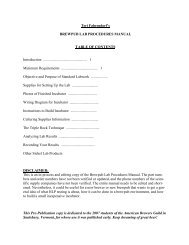New Lab Manual-2010SEP06.pub - Teri Fahrendorf
New Lab Manual-2010SEP06.pub - Teri Fahrendorf
New Lab Manual-2010SEP06.pub - Teri Fahrendorf
Create successful ePaper yourself
Turn your PDF publications into a flip-book with our unique Google optimized e-Paper software.
THE TRIPLE ROCK TECHNIQUE<br />
Arrange all your lab supplies before you begin. If you do not have a lab, arrange to use the<br />
Manager's Office undisturbed for the next hour.<br />
Prepare the lab area by closing doors and windows. Turn off fans that are blowing. Wipe off<br />
workspace counter with the denatured alcohol spray. Light up the alcohol burner anytime the<br />
Erlenmeyer flask or an open test tube is near. Continue to work near the flame.<br />
Take a clean 500 ml Erlenmeyer flask which has been hanging upside-down on a dowel or pegboard<br />
hook. That way it is not dusty or dirty and does not need to be sanitized, nor rinsed with<br />
city water. Measure 100 ml of distilled water into it and put it aside.<br />
Take the weighing dish off the gram scale and spray it top and bottom with the denatured alcohol.<br />
Wipe off with a clean paper towel and replace on the gram scale. Spray the spoon as well<br />
and then wipe it off.<br />
Tare the gram scale with the weighing dish on it. Measure 7 grams of HLP into the dish. (Use<br />
100 ml distilled water and 7 grams of HLP for every approximately 8 tanks to test.)<br />
Pour the HLP powder into the flask, put a clean piece of aluminum foil over the opening of the<br />
flask, and swirl gently. Put it on the single burner hot plate.<br />
Plug the hot plate in and turn it to high. Bring to a boil and boil the HLP solution for (+) or (-)<br />
2.5 minutes. Turn off the hot plate, and with a hot pad, remove the Erlenmeyer flask and place<br />
it on another hot pad to cool.<br />
While it is cooling, take the clipboard with a fresh Weekly HLP Test Log form and write down<br />
the required information about each beer that will be tested. Tank number, Beer type, Brew<br />
number, Date brewed, Yeast number, Prior yeast tank, Yeast generation number, etc.<br />
It is imperative that labwork be done on the fermenters weekly, in order to propagate only<br />
healthy yeast. If something has to slide in labwork due to time constraints, let it be the serving<br />
tanks. However, it is an excellent idea to test the servers in order to get an overall view of how<br />
your sanitation and transfer procedures are holding up.<br />
Extremely cloudy one-day old beer will often leave dead yeast in your test tube. Sometimes it is<br />
difficult to see through the haze. If you are concerned, you may want to do labwork twice a<br />
week.<br />
While the HLP is still cooling, take as many test tubes out of their plastic wraps as tanks you<br />
will be testing. By now the HLP solution is probably cool enough to handle. Use the hot pads if<br />
necessary. Pour solution into a test tube until it is about 1/2 to 2/3 full and cap it off. After all<br />
test tubes are full, allow them to cool in the rack some more. Discard excess HLP solution, or<br />
use it to test your beer engine, water, filter, etc, with the excess. Put hot test tubes aside to cool.<br />
11



